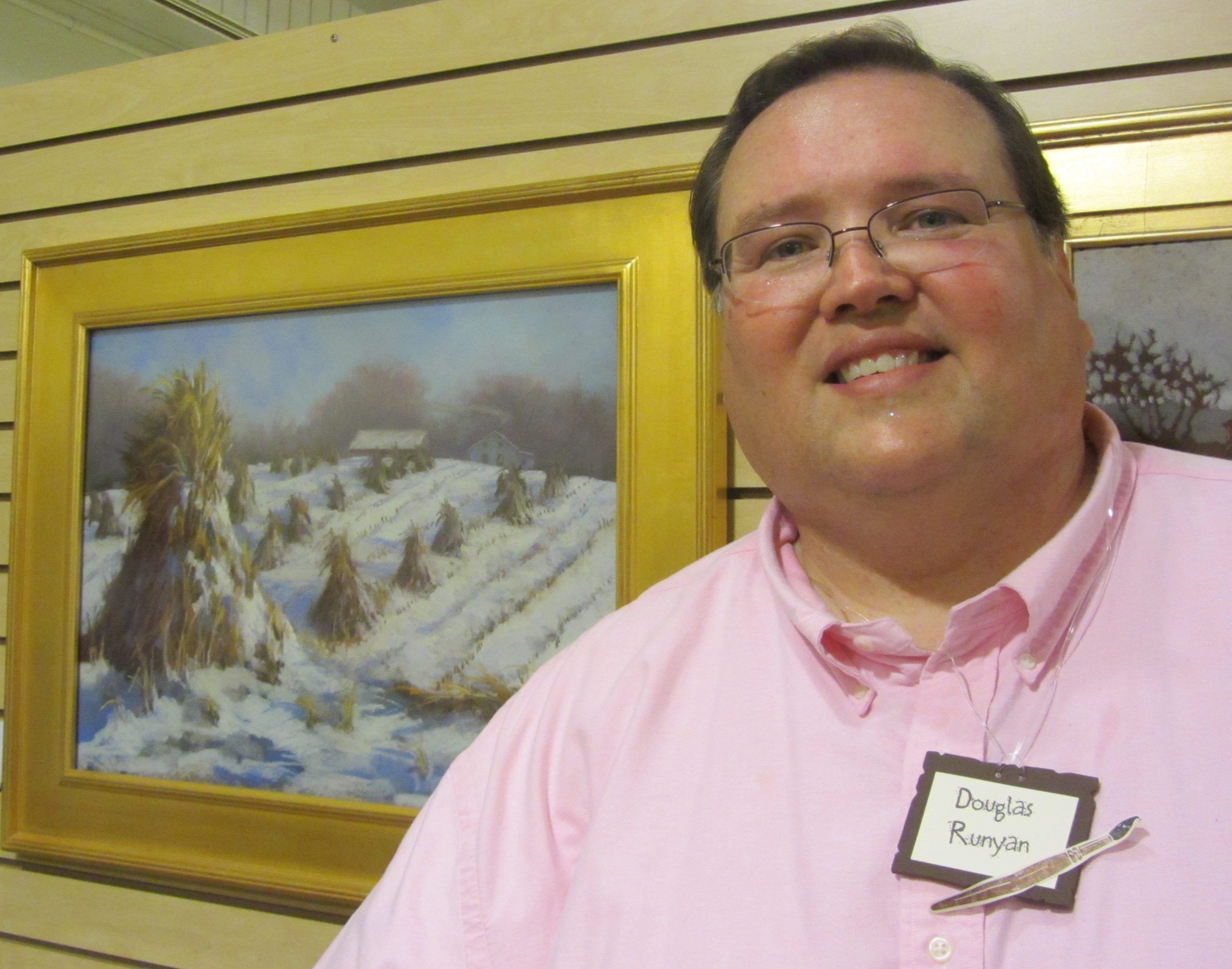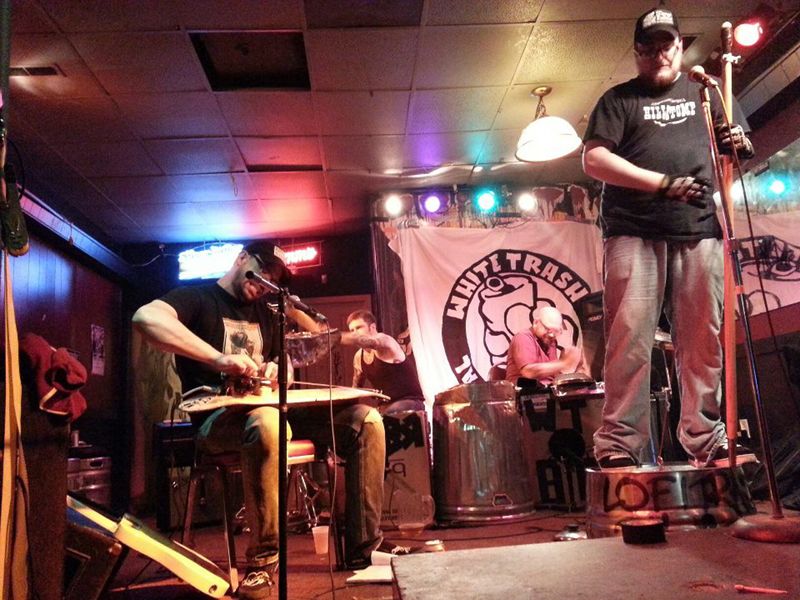With family roots burrowing through Indiana soil for over 200 years, Douglas Runyan is an artist whose deep connection to our state’s history is reflected in the beautiful landscapes that he paints. As an attorney by day, Runyan deals with family histories as he helps clients settle estates. As an artist in the evening, he pours over the hundreds of photographs taken all over Indiana, carefully deciding which landscape he will take on as his next challenge. Runyan attended art shows in Bloomington while he worked through law school. There he started to develop a strong appreciation for Indiana landscape painters, especially those from Brown County. He is particularly fond of renowned painter, T.C. Steele, a prominent member of the “Hoosier Group” of American impressionist painters.
Runyan started buying art in 1996, collecting many pieces from Indiana artists. His collection enhanced his love for Indiana and the history of art in our state. Runyan also has fond memories of the art history classes he attended while earning his undergraduate degree at Indiana University.
His love for art was evident, but until he turned 40 he had never taken an art class. He remembers being interested in art as a child and says, “I was a kid who liked to draw. I always had a pad and pencil with me. I didn’t just sit in front of the TV, I would draw at the same time.” On his 40th birthday, Runyan took some time to look at his life and acknowledged a creative hole that needed to be filled. “I decided to take a painting class,” he said. Runyan purchased a set of oil paints and canvas, then met with teacher Janice Reifsnider who happened to be teaching a class at the Decatur parks department. In a class of about a dozen people, he discovered his own talent. Runyan continued learning, seeking opportunities to take classes and eventually stumbled upon a new medium: soft pastel.
Some consider pastel, a chalky medium that is found in the form of sticks, a tool for drawing. Runyan disagrees and considers himself a painter. Pastel offers vivid color. The color effect of soft pastel is closer to the actual pigment than any other medium due to the simple fact that a pastel is pure powdered pigment mixed with a binder. With Runyan’s love of color, it stands to reason that he connected so quickly with the medium. “The moment I tried it I liked it,” said Runyan, “but you have to be careful with value or you can lose the lights and darks.”
Runyan’s technique involves the application of several layers. He begins with a Masonite surface primed with a sanded texture. The texture allows the pigments to grab onto something. Without the textured surface, his work wouldn’t be able to hold the layers. He begins with a sketch and then fills in the shapes with a thin layer of pastel. He often smooths the base layer with a gentle wash of alcohol applied with a brush.
“The alcohol washes over the pigments, melting the pastel into a smooth, translucent surface,” he explains. With his roadmap in place, he begins to build up the painting by applying small strokes of pastel pigment on top of one another, using a wide range of color, until the desired affect is achieved.
“The texture of my work is actual, not implied,” says Runyan. “If you look closely you can see the layers of pastel piled up from the canvas.”
An avid traveler, Runyan has collected hundreds of photographs that he stores on his computer and later uses as reference for his paintings. He enjoys traveling with his wife, and together they frequent the East Coast, often making extended stops in Cape Ann, Maine, a major art colony. Runyan carries his supplies with him when he travels and sometimes sets up to do a plein air painting. That’s when he is transported to the zone: a place where the real world falls away and full concentration is given to the canvas and the natural world surrounding him.
Once a year Runyan treats himself to a week-long artists’ retreat; he packs up and heads south to the motherland of Indiana landscape painters, Brown County. There he takes classes with Robert Hoffman, a fellow painter and mentor whom he speaks of with high regard. “He is teaching me to paint quickly and to focus. He made me become a painter.”
Runyan enjoys learning from experienced painters. “I like standing on the shoulders of others who have come before me,” he says. He enjoys taking the knowledge discovered by more seasoned painters and expanding on that; he explains that each generation learns from the last and, together, artists bring mediums and forms to new levels.
A lifelong learner and goal-oriented man, Runyan sets his sights high. One of his most admirable accomplishments was his acceptance by the Hoosier Salon. The group is over 90 years old and carries with it a great deal of clout. Runyan has long admired and respected the painters in that group and was honored to find himself included, just four years after he took his first painting class.
“It happened early for me,” says Runyan, still humbled by the fact that he is a member.
He is also a permanent artist represented by Fort Wayne’s Castle Gallery whose owner, Jody Hemphill-Smith, discovered Runyan as he painted from the sidewalk across the street. Hemphill-Smith observed his work on the easel and told him she would like to see the finished piece. Hemphill-Smith has been showing his pastel work in the gallery ever since.
Beyond the Hoosier Salon and Castle Gallery, Runyan makes two other significant Indiana shows part of his annual schedule. He competes for the privilege to show work in the annual Indiana Heritage Arts show in Brown County every June as well as the Ventures in Creativity Exhibit, a project put together by the Fort Wayne Artists Guild and the University of Saint Francis. Runyan enjoys competition and says, “It is difficult. Judges can be difficult. I want to get into these shows, and that motivates me.”
Setting goals is an effective means to productivity and success for Runyan. As he checks off old accomplishments, he quickly fills his list with new aspirations. His goals for the future are simple: create better work, paint more and stop the real job. He puts in his time at work and still dedicates several hours to painting at least three times each week.
According to Runyan, the best compliment he received was when a friend said of his work, “This looks like it was done by a dead painter.”
Runyan replied, “But all the good painters are dead, right?”
People who have seen this artist’s work up close know that statement isn’t so. As long as he keeps producing work, Runyan proves that statement false. With plans to pump up the quality and pace of his work in the future, one would be wise to keep tabs on this guy.


